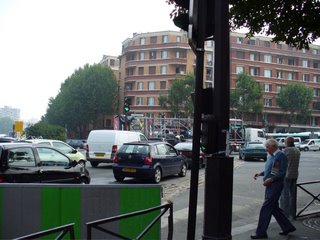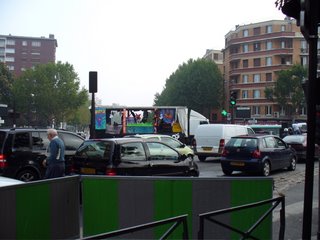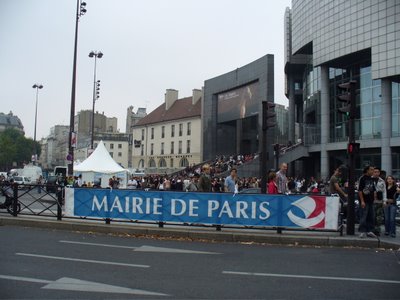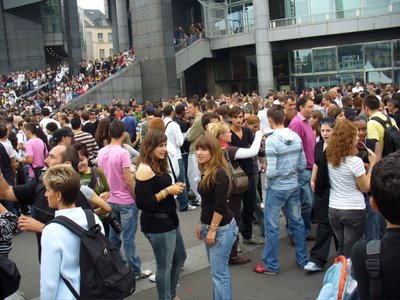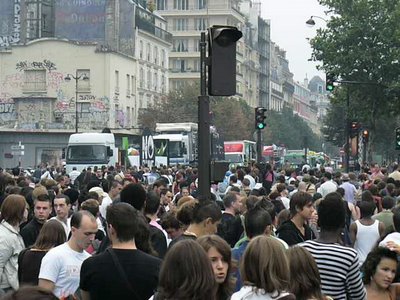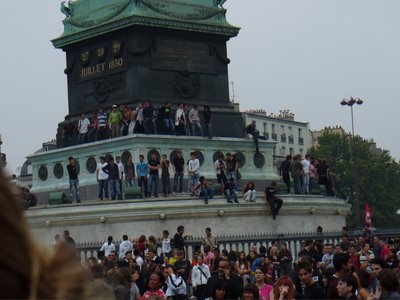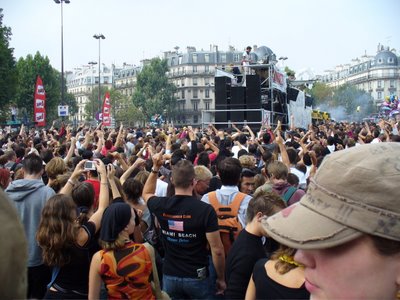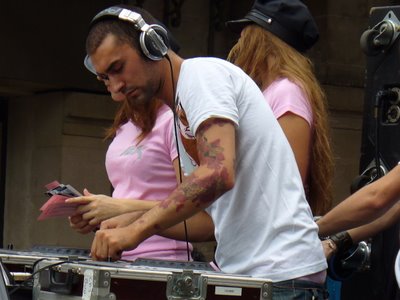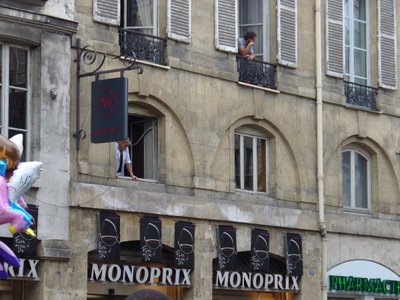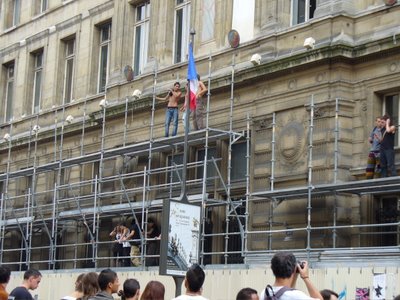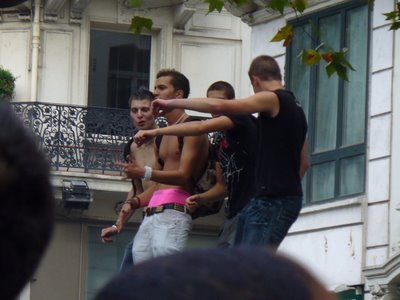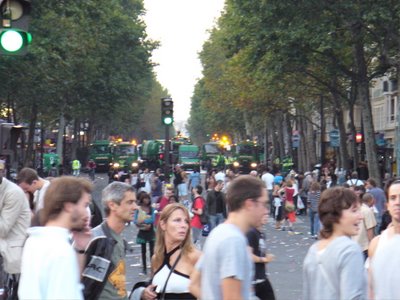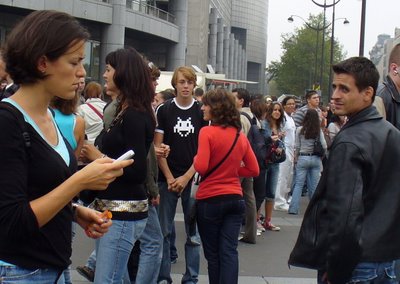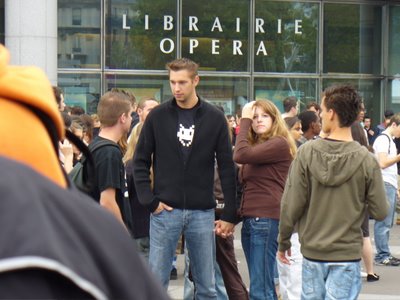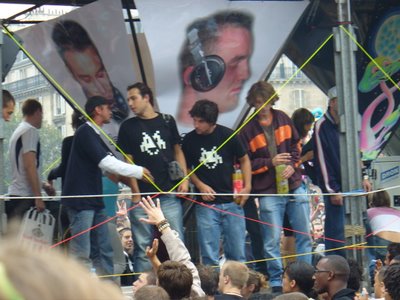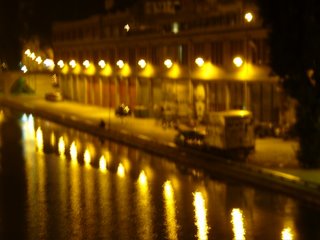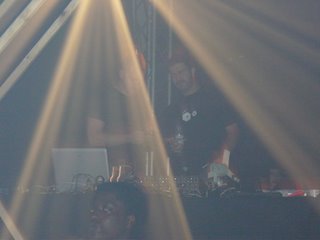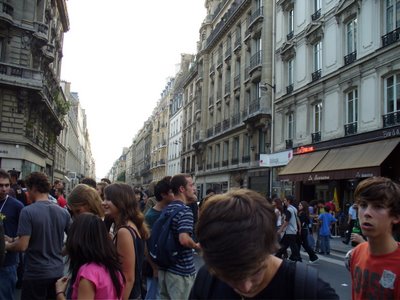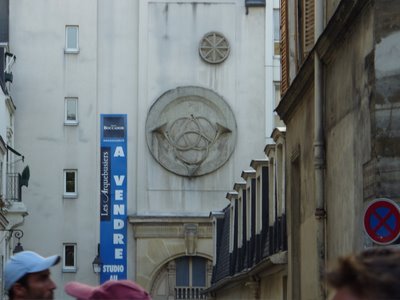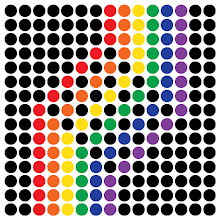Techno Parade (Part 1) : The Parade
ALL TECHNO-PARADE POSTS ARE DONE!.
Woo! So, Saturday was a very busy day for me, research/party-wise, so I'm breaking this up into 3 blog entries. This first one is about the Techno Parade itself (more on this in a bit), the second is on all the Space Invaders sightings at the parade (yes, it merits a separate post), and the last is on the Katapult Records afterparty that I went to. As a bit of narrative foreshadowing, this Saturday also resulted in me buying my baguettes at 6:30am on the way home!
So, I had almost forgotten that Paris hosts its own version of the Love Parade, called the Techno Parade (see also brief Wikipedia article in French). The parade is timed for mid-september, in the aftermath of la rentrée. La rentrée ("the return") is what happens after les vacances, when all of Paris (and France) take the entire month of August (and sometimes July) to travel somewhere warm and get distressingly dark tans (I wonder what the skin cancer rates are in this country). Mind you, when I say "all of Paris," I should more properly add "that can afford to travel;" although there are certainly less expensive vacation options available as well, many families can't afford the trip and stay in Paris. It was for this reason, in fact, that Paris started the Paris-Plage project a few years ago. During les vacances, the city turns large blocks of the Seine into a sort of beach, using tonnes of sand and other beach-like things.
One of the results of this mass vacation season is a sort of Americans-in-Cancún effect that lasts 4 weeks. In many of the favorite destinations for French vacationers, you have a huge influx of young people, determined to party and equipped with money that they've saved all year for this purpose. So, the Techno Parade serves two functions for two different groups: 1) it provides a nostalgic last-hurrah to the preceding month of partying for those still lingering in the afterglow of les vacances; and 2) it gives those who could not afford to travel a limited and temporary form of access to what les vacances might be like. In another, overlapping sense, the Techno Parade also offers to both groups a scene for aspiration through leisure, where they can attempt to conjure up and sustain an optimal experience on a massified scale that may not have been forthcoming during vacation. What I find most interesting about this whole endeavor is how the event brings together a nostalgic mix of remembering and forgetting, with a future-oriented aspiration for the ideal "good times."
Very little of this side of the Techno Parade, I should add, appears in the semi-official descriptions of the parade by the founding organization, Technopol (see link above). For their purposes, the Techno Parade was founded as a political intervention that put pressure on the state to reduce their antagonism of raves/clubs/soirées on the one hand, and also made an argument for the cultural importance of electronic dance music to a sometimes wary general public.
Alright, that's enough essay-writing for the moment. Let's return to the narrative! (with pics, of course!)
So, I had nearly forgotten about this event, were it not for one of the folks working at the front desk of my building, who had reminded me friday afternoon. I promptly cancelled all plans for Saturday and put new batteries in my camera. The parade was supposed to begin with a roundup of the floats at Bastille at noon, then take off from there at one o'clock on the parade route, with the lead floats beginning to arrive back at Bastille around 6pm. I left my place a bit later than I had wanted, leaving around 11:45am. Thankfully, the floats were late, as was evident by the fact that I saw a few of the floats drive by Porte des Lilas (my area), music blaring, still 30-45 minutes away from Bastille.
When I got to the place de la Bastille it was almost 12:30 and there were no floats to be seen, although the crowds were already gathering. This is a shot of the crowds in front of the Bastille opera house, although this is nowhere near as packed as it was an hour later.
I took a moment to grab a coffee at the café on the north end of the place, and then wandered around a bit through the crowds. After a little while, I was able to read from the crowd where they expected the floats to appear, so I found a good spot on top of a concrete bench from which to take some shots of the arriving floats. By the time the first floats appeared in the distance and sounded their horns, the sidewalks were densely packed and spilling onto the street.
Many people climbed up on the Bastille monument for a better view. This became really packed towards the end of the event.
When the floats finally started pulling into Bastille and taking their places, people began cheering, and demanding "du son!" ("sound!"), because none of the floats had started their music. In fact, most if not all of the floats were still being hurriedly finished by workers as they pulled into the square.
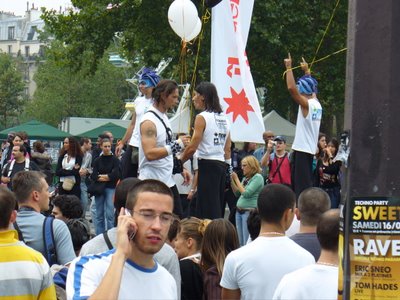
The parade was led by men on stilts. Why? I don't know.

The lead float, dedicated to an anti-famine charity drive
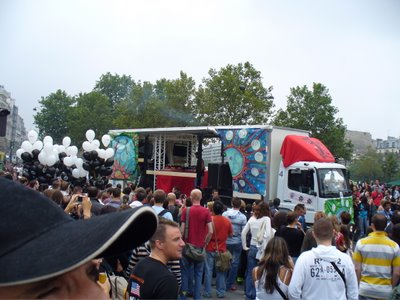
One of the psy-trance floats (I don't remember which)
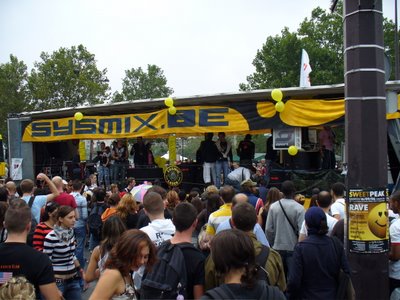
Belgium reprazent!
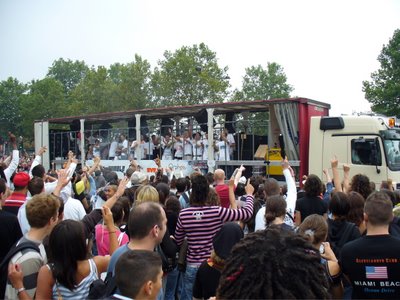
The MH Diffusion / Orphée float
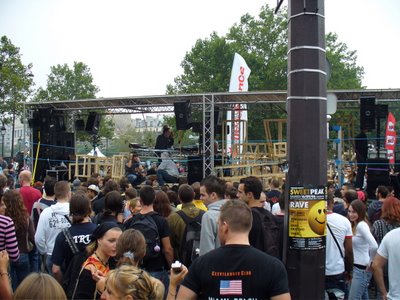
The Katapult float—but what's with all that wood?...
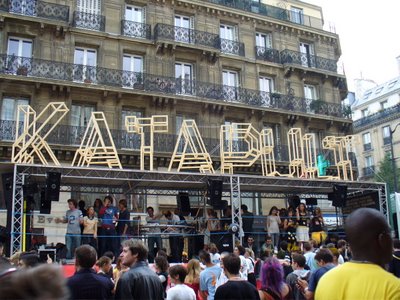
...aaah. I get it.
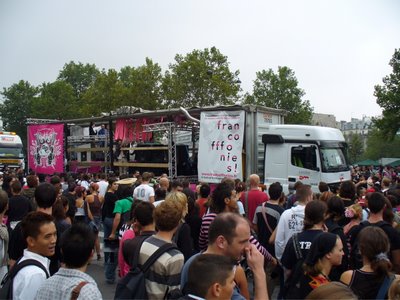
The Francofffonies float, dedicated to music from francophone countries (does Canada count?)
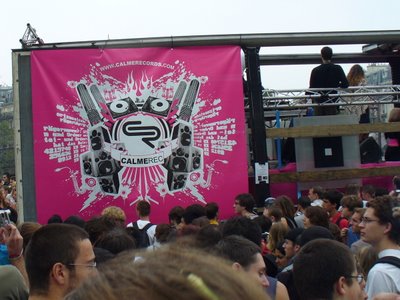
Some detail from the Francofffonies float. Notice anything? That's right: Chicago's Marina Towers!
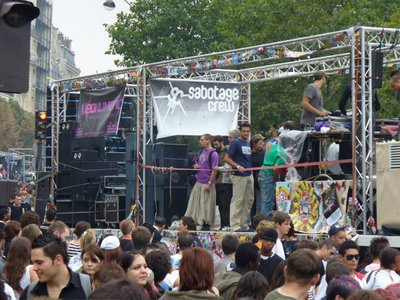
The Néonumeric/Flyman/Sabotage Crew float
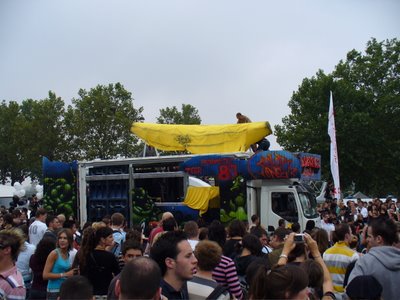
It's a banana. Why? I don't know.
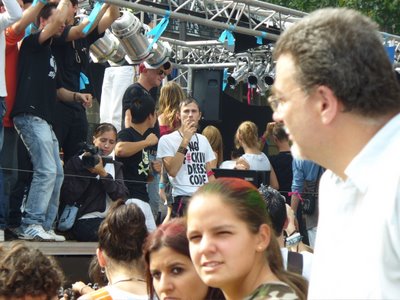
The NRJ float
I took that last photo mostly for the guy wearing the "NO F#CKING DRESS CODE" t-shirt. A lot has been and will be written on how dress codes have been used at clubs/parties to enforce segregation along more objectionable lines (e.g., class, race, sexuality). The topic is a bit too big to discuss in this already-sprawling post, and I want a few more weeks in Paris before I hold forth on that topic. But, nonetheless, I liked the shirt.
So, after a while, one of the larger floats finally decided to respond to the crowd's demand for sound. The crowd went nuts. One by one, other floats started up their systems and began blasting their music—some more powerfully than others. A DJ on one of the floats with the largest speaker-stack took advantage of the downtime before the actual parade to rev up the crowd. He used many of the standard DJ tricks for getting a crowd moving (e.g., dropping the bass and bringing it back suddenly, backspinning into a new track, cutting to silence before strong downbeats, etc), but in a very compressed manner. Most of these skills would be employed every 10 minutes in a DJ set at most—often far less in certain genres—but this DJ was dropping them twice a minute at least. He made particularly heavy use of a sampled solo trumpet fanfare in a flamenco style (referencing Ibiza, perhaps?), which he would use by cutting the current track to silence about 4 beats before a major downbeat, filling in with the trumpet sample, and then cutting back to the current track with heavier bass. Here's a picture of the crowd reaction:
These sorts of performative tactics became important once the parade got underway. As each float began to move out onto the parade route, about 20-30m of space was left between each float for a crowd to gather and follow. So the parade itself became a scene for the display of affinities and preferences, as various floats playing different genres of EDM (electronic dance music) and/or displaying different visual aesthetics sought to develop a large and enthusiastic following (in the most literal sense). As the parade progressed along rue Rivoli, I walked the length of the parade itself a few times to get a feel for the kinds of music being played, the kinds of décor applied to the floats, and of course who was gathering where. Then, I picked a couple of floats whose music I liked and spent a more extended amount of time following them to see how changeable the crowds around the floats were.
In general, I found the crowds to be rather volatile but not completely fickle. For example, I was behind the Katapult float for a long while, and I could divide those people following the float into three groups: 1) those who apparently knew people on the float; 2) those who were fans of Katapult or particularly fond of what they had heard so far; and 3) those who arrived and left rather casually, although still with enthusiasm (strangely enough for Paris, there was very little ennui). As soon as the music cut out (for example, to switch to another DJ) or the DJ lingered too long on a low-intensity track, group #3 would bolt for another float. If things didn't pick up within a couple of minutes, group #2 would start to dissolve. The result was that the Katapult float (like the others) went through cycles of high and low crowds, with sudden shifts in numbers as group #3 would gather or disperse. Although it might be tempting to argue for the importance of the "true" fans that stuck it out during the low phases and dismiss the larger and more capricious groups, I think these fast-moving masses were very important to the feel of the scene behind each float. The sudden arrival of a mass of young, variously intoxicated and very enthuasiastic people created an affective crucible: things got sweaty, raucous, loud, densely packed, rough, sexual, intimate, almost destructive, and very intense. And, judging by the reactions of those both on the float and behind it, all of this was optimal experience.
I also spent some time behind the Coontak et les pervenches de plaisir float. It was a much smaller float—in fact, just a flatbed truck with a few speakers, a DJ and two hot girls in pink, but they were playing a steady stream of very well selected classic house (this year's Techno Parade theme was a celebration of 20 years of house). Also, one of the DJs spinning on the truck had this amazing tattoo; what was obviously once a strawberry birthmark was re-worked into a black and red butterfly pattern (see below). Apparently, Coontak is a clothing company, and I'm guessing that their name is an imaginative respelling of contacte. However, the design of their logo (which you can see on their website) separates "coon" from "tak" visually, which made for an odd scene as I followed a black truck with black speakers blaring "soulful" (read: black) house draped with banners that, from a distance, read "Coon." Hmm. Also, if you check out their website, stick around for about 60 seconds for the background music to turn pornographic. Also, note their pervenches de plaisir photo gallery. Apparently, pervenche means both periwinkle and meter-maid—you know, parking enforcement in the days when women police officers weren't trusted to do anything dangerous. So, the pervenches de plaisir are these sexy girls, handing out fake parking tickets and wearing stylized (American) police hats, hot pink boob tops, and super-short hot pants.
Certainly, part of the spectacle of the Techno Parade was the occupation of general public space for the fashioning of a specific or inflected public space. This movement created some interesting and at times amusing tensions and releases—especially among those who were not entirely willing parties to this inf(l)ection of general space. Most commonly, this ranged from mild bemusement to mild exasperation from some. Some of the locals seemed curious—although they stayed in their apartments:
Some onlookers joined in on impulse, like one of the women in my building, who was out shopping at BHV with her friends, then followed the noise outside, and spent the next few hours following the parade. This inflection of public space, however, happened with the approval of the city's authorities, so the event was to be contained within sanctioned boundaries. Unsurprisingly, then, there were numerous violations:
I want to spend a moment with this last photo, since, as the caption says, everything about it was a common sight. Although you can't quite make it out from the photo, these 4 guys were on top of a bus shelter, which is a fragile-looking but obviously sturdy structure of metal and plexiglas. Everywhere along the parade route, you saw people (mostly guys) climbing things to get a better view of the parade and to the parade. In one case, there were so many bodies on the roof of a bus shelter, that the roof bent rhytmically under their collective movement and caused the sign designating the bus stop to fall to the street. Without comment, someone on the ground picked it up, put it under his arm, and continued walking.
My double-formulation "a view of/to the parade" in the previous paragraph points to a very salient (to my eyes) aspect of the day's events. Throughout the parade, and on a mass scale, the male body was much more of a spectacle than I am used to seeing in North American mass events (with the exception of gay pride parades, which is not completely unrelated). I saw at least as much bared male flesh as I did female, and the males were certainly more assertively demanding recognition and attention to their bodies. Also, those bodies often showed a great deal of care and maintenance: trim physiqes, dark tans, shaved or waxed chests, lots of hair product, fitted jeans or low-slung jeans to show off the ass, etc. Hot pink was very popular among the guys; a common look for many men that day was a darkly tanned (shaved) torso, set off against hot pink boxer briefs and then very low slung jeans. Most interestingly (at least for me) was how much same-sex play took place between men during the parade. Again, far more than women, I saw men holding hands with their girlfriends while stealing kisses from their buddies, young shirtless guys grinding on each other, grabbing/slapping each other's asses, then flirting with a girl that caught their eye. On the other hand, I have no memory of women doing the same thing, even though it's a common sight for me at big clubs/events in North America. Admittedly, a lot of this was "just" play, but it bordered between ironic play and earnest play in a manner that has made the Girls Gone Wild video industry zillions of dollars. I could chalk up one or two incidents to exstasy use, but as a broad practice there seems to be something to be said about the sexualization of masculinity here. It certainly isn't how we make masculinity in N. America.
All of this creates an interesting counterpoint with the other salient aspect of male bodies at the parade: sexual interest/pursuit/agression towards females. As it is, continental Europe in general seems to permit and expect a more "forward" male suitor; however, the combination of laissez-faire, carnivalesque and intoxication at this event elicited a much wider range of courtship practices. I frequently saw guys trying to get the attention of girls on floats and begging them to come down and dance with them; another common tactic was to touch a girl on the shoulder (or, if you're disinhibited, somewhere more private) as you pass her and if she doesn't glare at you in disdain, you go back and talk her up. If a girl demeured or said "non," some more persistent men would grab her hand or forearm and plead with her to stay, although their grip always seemed loose enough for the girl to extricate herself without a much effort; it's the thought that counts, so to speak. Some boys would take advantage of the crush of people behind the floats to grind on girls. I never saw anyone come to physical harm over it, but the body practices were invasive and agressive at times, and often had little respect for the word "no." And I use the term "girls" here repeatedly because age had a great deal to do with this, as well. I saw no 30-something women being aggressively pursued; on the other hand, these young girls were not defeneless, either. They obviously had a fair bit of experience in handling the more polite quotidian advances, so most of them used the same rituals of disengagement, refusal and frank dismissal—only more emphatically and with greater effort. More than once, I noticed that their boyfriends would let them fend for themselves, holding their hands but remaining uninvolved, until some boundary was crossed. All of this made me realize how lucky-unlucky I am to be exempt from that combination of female and pretty that elicits these encounters here. On the one hand, I'm obviously lucky to be spared the frequent pestering and sometimes frightening agression. On the other hand, I'm unlucky in the sense that, quite frankly, guys are less likely to talk to me. All of the contacts I've made so far have been female or introduced through females. There's an entire erotic economy behind making contacts in the field (although often sublimated through channels of prestiege, coolness, wealth, escape), and I have little to offer potential male contacts in that respect.
Epilogue: Following
Looking back on my notes of this event, the word "following" appears rather frequently. Indeed, leading and following were important aspects of the the Techno Parade, although I feel that the word underdescribes the phenomenon. In a way, it seems like much of this event has to do with guided flows. That is, rather than following a singular path like a train car on rails, the crowd seemed to move like water: tumbling forward within channels of barriers, sometimes spilling over, and only predictable at a very general level. The Techno Parade, then, provides a spatial and temporal frame—better yet, a channel—within which participants can plot and/or discover their own paths through leisure and recreation. Mind you, I don't want to entirely dismiss the controlling and normalizing aspect of the parade's organization and execution; for all the paths available to choose, most still moved forward, staying behind or beside floats, obeying the direction of security staff, and avoiding anything more dangerous than mischeif. [For more pictures of the event and previous years', check out Planet-Tekno.]
